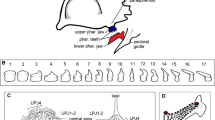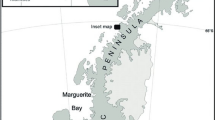Synopsis
The assumption that parrotfishes represent a single group of grazing herbivores is addressed by morphological, functional and ecological analyses. This assumption is rejected. The 24 scarine parrotfishes from the Great Barrier Reef, Australia, are divided into two functional groups: excavators and scrapers. The osteology and myology of the jaws of all 24 species were examined, and a detailed description of a representative species from each group is provided. The relative weights of the major jaw structures of five representative species were quantified. Morphological differences between species were interpreted in a functional context and were assessed based on observations of feeding in the field. Species in the two functional groups show major group-related differences in their bite speeds, microhabitat utilization patterns, and form and extent of substratum excavation during grazing. Group-related differences are also apparent in feeding rates, foray sizes and bite rates. The division of the species into two functional groups is supported by both morphological and behavioural observations. The ecological significance of two functional groups within the family is discussed in relation to the role of parrotfishes on reefs, particularly in terms of bioerosion.
Similar content being viewed by others
References cited
Adey, W.H. & J.M. Vassar. 1975. Colonization, succession and growth rates of tropical crustose coralline algae (Rhodophyta, Cryptonemiales). Phycologia 14: 55–69.
Barel, C.D.N. 1983. Towards a constructional morphology of cichlid fishes (Teleostei, Perciformes). Neth. J. Zool. 33: 357–424.
Barnes, D.J. 1970. Coral skeletons: an explanation of their growth and structure. Science 170: 1305–1308.
Bellwood, D.R. 1986. The functional morphology, systematics and behavioural ecology of parrotfishes (family Scaridae), Ph.D. Thesis, James Cook University of North Queensland, Townsville, 489 pp.
Brock, R.E. 1979, An experimental study on the effects of grazing by parrotfishes and the role of refuges in benthic community structure. Mar. Biol. 51: 381–388.
Choat, J.H. & D.R. Bellwood. 1985. Interactions amongst herbivorous reef fishes on a coral reef: the influence of spatial variation. Mar. Biol. 89: 221–234.
Choat, J.H. & J.E. Randall. 1986. A review of the parrotfishes (family Scaridae) of the Great Barrier Reef of Australia with description of a new species. Rec. Aust. Mus. 38: 175–228.
Choat, J.H. & D.R. Robertson. 1975. Protogynous hermaphroditism on fishes of the family Scaridae. pp. 263–283.In: R. Rheinboth (ed.) Intersexuality in the Animal Kingdom, Springer Verlag, Heidelberg.
Clements, K.D. & D.R. Bellwood. 1988. A comparison of the feeding mechanisms of two herbivorous labroid fishes, the temperateOdax pullus and the tropicalScarus rubroviolaceus. Aust. J. Mar. Freshwater Res. 39: 87–107.
Frydl, P. & C.W. Steam. 1978. Rate of bioerosion by parrotfish in Barbados reef environments. J. Sed. Petrol. 48: 1149–1168.
Gans, C. & W.J. Bock. 1965. The functional significance of muscle architecture — a theoretical analysis. Ergebnisse der Anatomie und Entwicklungsgeschichte 38: 115–142.
Goldman, P. & F.H. Talbot. 1976. Aspects of the ecology of coral reef fishes. pp. 125–154.In: O.A. Jones & R. Endean (ed.) Biology and Geology of Coral Reefs, Volume III: Biology 2, Academic Press, New York.
Gygi, R.A. 1975.Sparisoma viride (Bonnaterre), the stoplight parrotfish, a major sediment producer on coral reefs of Bermuda? Eclogae Geologicae Helvetiae 68: 327–359.
Hatcher, B.G. 1981. The interaction between grazing organisms and the epilithic algal community of a coral reef: a quantitative assessment. Proc. 4th Int. Coral Reef Symp. 2: 515–524.
Hatcher, B.G. 1983. Grazing in coral reef ecosystems. pp. 164–179.In: D.J. Barnes (ed.) Perspectives on Coral Reefs, Australian Institute of Marine Science, Townsville.
Hatcher, B.G. & A.W.D. Larkum. 1983. An experimental analysis of factors controlling the standing crop of the epilithic algal community on a coral reef. J. Exp. Mar. Biol. Ecol. 69: 61–84.
Hay, M.E. 1984. Predictable spatial escapes from herbivory: how do these affect the evolution of the herbivore resistance in tropical marine communities. Oecologia 64: 396–407.
Hay, M.E., T. Colburn & D. Downing. 1983. Spatial and temporal patterns in herbivory on a Caribbean fringing reef: the effects on plant distribution. Oecologia 58: 299–308.
Hay, M.E. & P.R. Taylor. 1985. Competition between herbivorous fishes and urchins on Caribbean reefs. Oecologia 65: 591–598.
Hutchings, P.A. 1986. Biological destruction of coral reefs. A review. Coral Reefs 4: 239–252.
Kaufman, L.S. & J.P. Ebersole. 1984. Microtopography and the organization of two assemblages of coral reef fishes in the West Indies. J. Exp. Mar. Biol. 78: 253–268.
Kiene, W.E. 1988. A model of bioerosion on the Great Barrier Reef. Proc. 6th Int. Coral Reef Symp. 3: 449–454.
Lewis, S.M. & P.C. Wainwright. 1985. Herbivore abundance and grazing intensity on a Caribbean coral reef. J. Exp. Mar. Biol. Ecol. 87: 215–228.
Liem, K.F. 1980. Adaptive significance of intra- and interspecific differences in the feeding repertoires of cichlid fishes. Amer. Zool. 15: 427–454.
Miller, A.C. 1982. Effects of differential fish grazing on the community structure of an intertidal reef flat at Enewetak Atoll, Marshall Islands. Pac. Sci. 36: 467–482.
Robertson, D.R., N.V. Polunin & K. Leighton. 1979. The behavioural ecology of three Indian Ocean surgeonfishes (Acanthurus lineatus, A. leucosternon andZ. scopas): their feeding strategies and social mating systems. Env. Biol. Fish. 4: 125–170.
Russ, G. 1984a. Distribution and abundance of herbivorous grazing fishes in the central Great Barrier Reef. I. Levels of variability across the entire continental shelf. Mar. Ecol. Prog. Ser. 20: 23–34.
Russ, G. 1984b. Distribution and abundance of herbivorous grazing fishes in the central Great Barrier Reef. II. Patterns of zonation of mid-shelf and outershelf reefs. Mar. Ecol. Prog. Ser. 20: 35–44.
Russ, G. 1984c. Abundances of herbivorous fishes and measures of food availability across the continental shelf in the central Great Barrier Reef region. pp. 63–73.In: Productivity and Processes in Island Marine Ecosystems, UNESCO, Paris.
Steneck, R.S. 1988. Herbivory on coral reefs: A synthesis. Proc. 6th Int. Coral Reef Symp. 1: 37–49.
Tedman, R.A. 1980. Comparative study of the cranial morphology of the labridsChoerodon venustus andLabroides dimidiatus and the scaridScarus fasciatus (Pisces: Perciformes). II. Cranial myology and feeding mechanisms. Aust. J. Mar. Freshwater Res. 31: 351–372.
Van Hasselt, M.J.F.M. 1979. Morphology and movements of the jaw apparatus in some Labrinae (Pisces: Perciformes). Neth. J. Zool. 29: 52–108.
Wainwright, P.C. 1988. Morphology and ecology: functional basis of feeding constraints in Caribbean labrid fishes. Ecology 69: 635–645.
Williams, D.McB. 1982. Patterns in the distribution of fish communities across the central Great Barrier Reef. Coral Reefs 1: 35–43.
Winterbottom, R. 1974. A descriptive synonymy of the striated muscles of the Teleostei. Proc. Acad. Nat. Sci. Philadelphia 125: 224–317.
Author information
Authors and Affiliations
Rights and permissions
About this article
Cite this article
Bellwood, D.R., Choat, J.H. A functional analysis of grazing in parrotfishes (family Scaridae): the ecological implications. Environ Biol Fish 28, 189–214 (1990). https://doi.org/10.1007/BF00751035
Received:
Accepted:
Issue Date:
DOI: https://doi.org/10.1007/BF00751035




